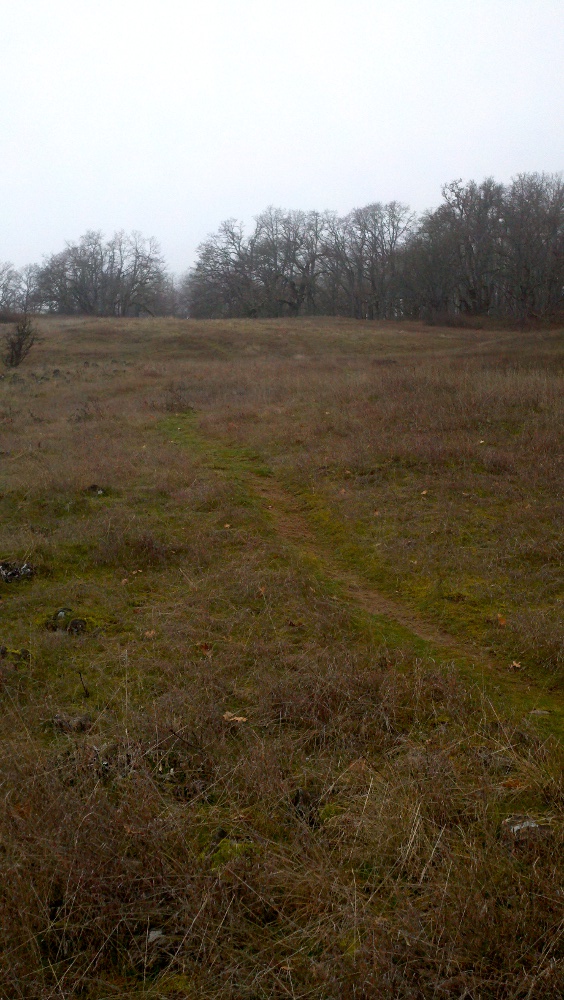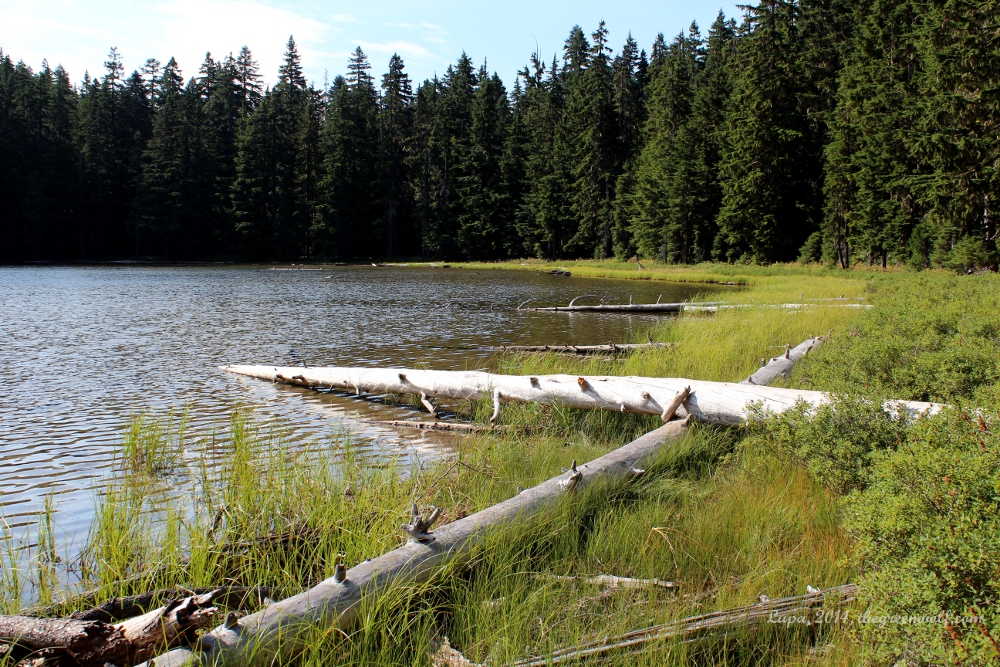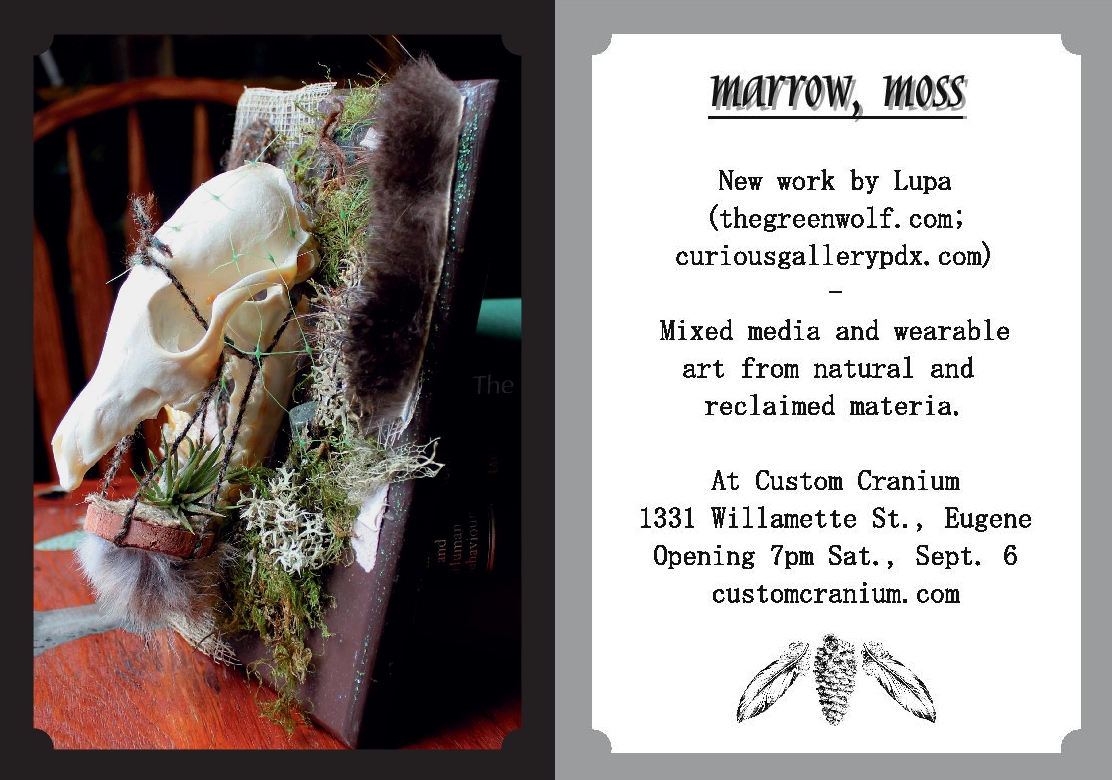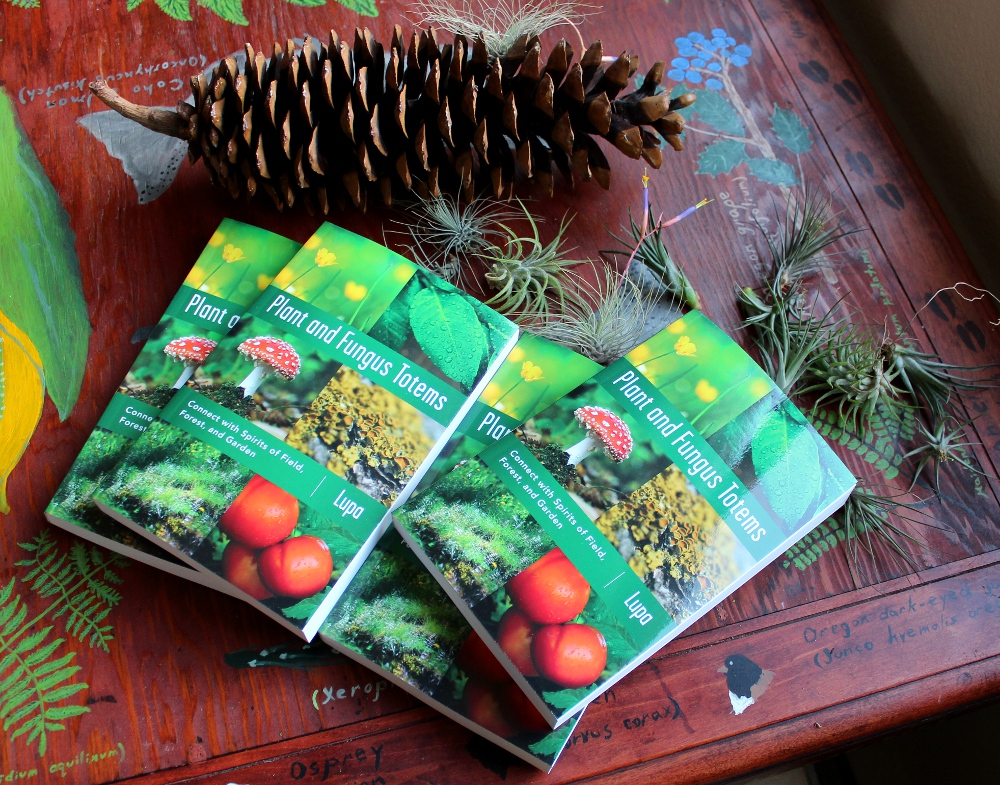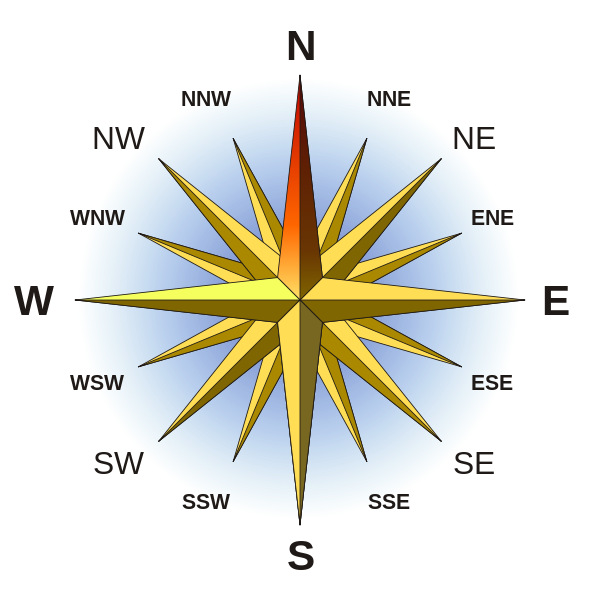(You can click on the pictures in this post to get bigger versions thereof.)
So last week I mentioned that I was escaping into the wilderness for a bit. I haven’t been backpacking in two years, since last summer was eaten up by a day job plus keeping my self-employed efforts rolling, and I wanted to get at least one good excursion in before the summer was out. My original plan had involved Wahtum Lake to Eagle Creek trailhead over the full moon, but the projected temperatures for those few days reached into the hundreds, and I wasn’t really up for heat stroke while carrying a 45 pound pack. (See? My Wilderness First Responder training did something for me!) Then as soon as the heat broke, a storm system came in, and I had no interest in being up at any elevation with the possibility of lightning (self-preservation is a great sense to have.) By that point a couple of project deadlines were looming, so I needed to put those first–yet another delay.
Finally, though, the clouds (literal and metaphorical) cleared, and last Wednesday through Friday was forecast to be clear and not too hot, not too cold, just right. I decided to change venues and plans; rather than spending all three days slowly picking my way down the path from Wahtum Lake to Eagle Creek, I decided I’d hike in to Upper Twin Lake, set up camp, have one whole day to wander the trails in the area, and then hike back out on the third day. I’ve done day hikes at the lake several times, and it’s really a wonderful place–far enough away from Portland that it’s not overrun by tourists and weirdos, nicely graded trails through beautiful mixed-conifer forests recovering from logging a few decades back, and delightfully free of mosquitoes.
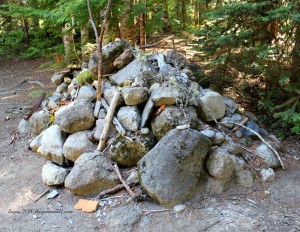 So I had my partner drive me out to the trailhead, which was a bit of an adventure in and of itself. He’d never been so close to Mt. Hood before, and there are some lovely views on the way out, so I got to show him a bit of my life he hadn’t experienced before. We took a brief detour for my annual pilgrimage to Pioneer Woman’s Grave near the trailhead. When the Mt. Hood Highway (Highway 26) was being built in the 1920s, workers unearthed the grave of a woman buried in a wagon box with the remnants of a wagon tongue as her headstone. No one knows her name, but the informational sign near where she was reburied gives a clue. Back in the 1800s, the only road through the Cascades in this area was the Barlow Road, a toll road stretching from the Columbia River to the Willamette Valley (part of 26 follows the Barlow Road). A superintendent of the road met a man who had just lost his wife to illness and buried her nearby, and was comforting their two young children. I usually only head out to this area once a year, so I always stop at the grave and leave my expired Northwest Forest Pass in the caern. (You can see it as a bit of orange and black in the center of the picture.)
So I had my partner drive me out to the trailhead, which was a bit of an adventure in and of itself. He’d never been so close to Mt. Hood before, and there are some lovely views on the way out, so I got to show him a bit of my life he hadn’t experienced before. We took a brief detour for my annual pilgrimage to Pioneer Woman’s Grave near the trailhead. When the Mt. Hood Highway (Highway 26) was being built in the 1920s, workers unearthed the grave of a woman buried in a wagon box with the remnants of a wagon tongue as her headstone. No one knows her name, but the informational sign near where she was reburied gives a clue. Back in the 1800s, the only road through the Cascades in this area was the Barlow Road, a toll road stretching from the Columbia River to the Willamette Valley (part of 26 follows the Barlow Road). A superintendent of the road met a man who had just lost his wife to illness and buried her nearby, and was comforting their two young children. I usually only head out to this area once a year, so I always stop at the grave and leave my expired Northwest Forest Pass in the caern. (You can see it as a bit of orange and black in the center of the picture.)
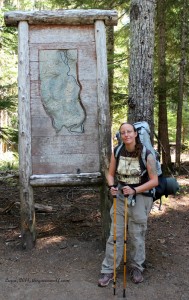 Once we got to the trailhead, I slung my pack up, got my hiking poles, and prepared to head in the three miles to the lake. I asked my partner to take a quick picture of me first, next to the informational sign showing the Pacific Crest Trail (PCT) and nearby trails to the lakes. If I look a little slumped over, it’s for good reason; this was my first time using this particular pack so I was getting used to the weight distribution. And as this was my first multi-night backpacking trip I had more food and water than usual. All told the pack was a little over a third of my weight, and it took me a little while to get used to carrying it, but by the first mile in I was making good time.
Once we got to the trailhead, I slung my pack up, got my hiking poles, and prepared to head in the three miles to the lake. I asked my partner to take a quick picture of me first, next to the informational sign showing the Pacific Crest Trail (PCT) and nearby trails to the lakes. If I look a little slumped over, it’s for good reason; this was my first time using this particular pack so I was getting used to the weight distribution. And as this was my first multi-night backpacking trip I had more food and water than usual. All told the pack was a little over a third of my weight, and it took me a little while to get used to carrying it, but by the first mile in I was making good time.
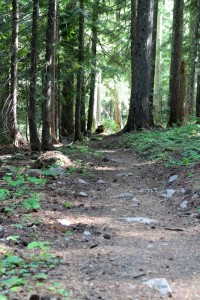 Because the trail isn’t especially steep or rocky, it’s easier for me to appreciate the scenery as I go along. (Strained muscles, ragged breathing and rough terrain are all rather distracting.) It’s really one of my favorite things about the trail to Upper Twin Lake; the first half is PCT, which is specifically graded to be more gentle, and then the trail that splits off to the lake itself is equally nice. Both on the way in and out, I was able to get a good look at what was going on around me. The Douglas fir and western hemlock trees were generally in good health, and the fir in particular had been prolific with little seedlings and saplings everywhere there was an opening. I was more concerned about the pines; many of them were sick or dead, some with bark beetles, and some that looked like they’d been attacked by fungus, perhaps after being weakened by the beetles. I admit any time I saw a young pine tree I cheered for it a bit, and wished it well.
Because the trail isn’t especially steep or rocky, it’s easier for me to appreciate the scenery as I go along. (Strained muscles, ragged breathing and rough terrain are all rather distracting.) It’s really one of my favorite things about the trail to Upper Twin Lake; the first half is PCT, which is specifically graded to be more gentle, and then the trail that splits off to the lake itself is equally nice. Both on the way in and out, I was able to get a good look at what was going on around me. The Douglas fir and western hemlock trees were generally in good health, and the fir in particular had been prolific with little seedlings and saplings everywhere there was an opening. I was more concerned about the pines; many of them were sick or dead, some with bark beetles, and some that looked like they’d been attacked by fungus, perhaps after being weakened by the beetles. I admit any time I saw a young pine tree I cheered for it a bit, and wished it well.
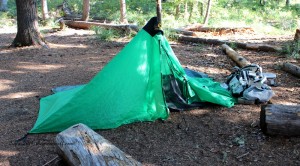 Once I got to the lake, I chose a campsite on the west side of the water so I could enjoy the first morning’s light a little sooner. I didn’t want to fuss with a campfire, so evenings were mostly going to be spent conserving my heat in the tent, and I figured the sooner I could get sunlight in the morning the better. My ultralight tent is a tiny thing, with barely enough room for me (I have no idea how a taller person would sleep in it, given that I can just stretch out enough at the widest point.) But it was cozy and safe, and it became my home sweet home for the next couple of days.
Once I got to the lake, I chose a campsite on the west side of the water so I could enjoy the first morning’s light a little sooner. I didn’t want to fuss with a campfire, so evenings were mostly going to be spent conserving my heat in the tent, and I figured the sooner I could get sunlight in the morning the better. My ultralight tent is a tiny thing, with barely enough room for me (I have no idea how a taller person would sleep in it, given that I can just stretch out enough at the widest point.) But it was cozy and safe, and it became my home sweet home for the next couple of days.
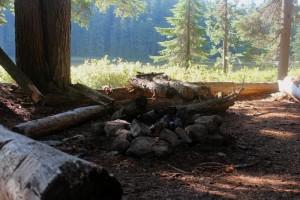 The first night was kind of rough. I get cold fairly easily, and my sleeping bag was only rated down to about 45 degrees; I really need to see about upgrading if I can find a better-rated ultralight that doesn’t take up much more room. So while I was warm a good part of the night, every so often a chill would slip into the tent and wake me. That and my bladder seemed to be conspiring to wake me every couple of hours, no doubt due to all the water I drank on the trail. So I didn’t get more than a couple of hours of sleep at a time, but since I went to bed at dusk, I had a good twelve hours of resting and sleeping by the time I woke the next morning. And was it worth it! That first time the sun came up over the trees in the east, the lake sparkled and all my crankiness at the nighttime dissolved in an instant.
The first night was kind of rough. I get cold fairly easily, and my sleeping bag was only rated down to about 45 degrees; I really need to see about upgrading if I can find a better-rated ultralight that doesn’t take up much more room. So while I was warm a good part of the night, every so often a chill would slip into the tent and wake me. That and my bladder seemed to be conspiring to wake me every couple of hours, no doubt due to all the water I drank on the trail. So I didn’t get more than a couple of hours of sleep at a time, but since I went to bed at dusk, I had a good twelve hours of resting and sleeping by the time I woke the next morning. And was it worth it! That first time the sun came up over the trees in the east, the lake sparkled and all my crankiness at the nighttime dissolved in an instant.
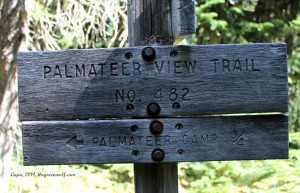 I decided to explore some trail-miles I hadn’t been on before. Every time I had hiked to Upper Twin Lake I’d seen signs for Palmateer, which started by the lake and curved along the other side of the ridge to meet up with the PCT. It’s a much narrower and a bit rougher trail than the rest, but still well-maintained and with some absolutely gorgeous views. Some of the signage along the way was missing so I was consulting my map a bit more than usual, but I figured out where everything was and had a lovely day of it. Once I hit the PCT again I decided to hike back to the trailhead because it’s the only place for miles with a port-a-john and has the best phone reception to boot (and 3G internet!) After a bit of a break up that way, I hiked on back to camp, and rested after what ended up being ten miles of stomping around in the woods.
I decided to explore some trail-miles I hadn’t been on before. Every time I had hiked to Upper Twin Lake I’d seen signs for Palmateer, which started by the lake and curved along the other side of the ridge to meet up with the PCT. It’s a much narrower and a bit rougher trail than the rest, but still well-maintained and with some absolutely gorgeous views. Some of the signage along the way was missing so I was consulting my map a bit more than usual, but I figured out where everything was and had a lovely day of it. Once I hit the PCT again I decided to hike back to the trailhead because it’s the only place for miles with a port-a-john and has the best phone reception to boot (and 3G internet!) After a bit of a break up that way, I hiked on back to camp, and rested after what ended up being ten miles of stomping around in the woods.
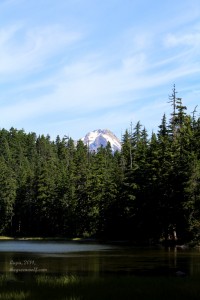 My second evening was nice and quiet; I walked a lot of laps around the lake, about a half mile circuit, because I wanted to make sure and remember this place that had treated me so well. I saw the black-tailed deer that had been visiting my camp periodically, and watched the gray jays and juncos and bushtits in their evening activities. I had a nice supper of jerky and oatmeal, and curled up in my tent to reflect on the sights of the day.
My second evening was nice and quiet; I walked a lot of laps around the lake, about a half mile circuit, because I wanted to make sure and remember this place that had treated me so well. I saw the black-tailed deer that had been visiting my camp periodically, and watched the gray jays and juncos and bushtits in their evening activities. I had a nice supper of jerky and oatmeal, and curled up in my tent to reflect on the sights of the day.
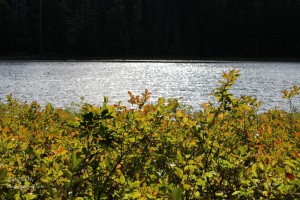 And then morning came, and I slowly let myself prepare to leave this place. I spent a little time sketching, and a little time meditating, and carefully picked over my campsite as I packed up my belongings to be sure nothing was left behind. I slowly ambled out the trail, taking two hours to hike the three miles back to the trailhead where my partner was waiting. It was a bittersweet parting with the lake, sad that I had to be leaving behind this beautiful place that I probably won’t visit again until next year, but glad to be returning home to a more comfortable bed and a shower.
And then morning came, and I slowly let myself prepare to leave this place. I spent a little time sketching, and a little time meditating, and carefully picked over my campsite as I packed up my belongings to be sure nothing was left behind. I slowly ambled out the trail, taking two hours to hike the three miles back to the trailhead where my partner was waiting. It was a bittersweet parting with the lake, sad that I had to be leaving behind this beautiful place that I probably won’t visit again until next year, but glad to be returning home to a more comfortable bed and a shower.
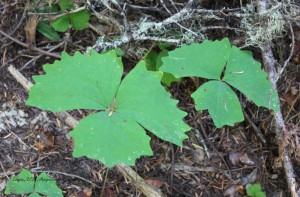 All in all, I really needed this trip. 2014 has been a year of challenges, and while I’ve tried to keep to my hike once a week self-care, it hasn’t always worked out that way. I need regular time in wilderness to be happy and healthym and I need a lot of solo time, too. It’s good for me to take measured risks, to remind myself as I get older that I’m still a capable adult, that all the training and experience I have in the outdoors means something, and that despite the media screaming about isolated cases of hikers falling off cliffs and being eaten by bears and attacked by lunatic hermits, I know how to keep myself safe out here. More importantly, it’s good to recharge, to have silence, where there’s no one trying to get my attention, and I can sort out my thoughts on my own. Nature heals, and I am much better for the time I spent in it.
All in all, I really needed this trip. 2014 has been a year of challenges, and while I’ve tried to keep to my hike once a week self-care, it hasn’t always worked out that way. I need regular time in wilderness to be happy and healthym and I need a lot of solo time, too. It’s good for me to take measured risks, to remind myself as I get older that I’m still a capable adult, that all the training and experience I have in the outdoors means something, and that despite the media screaming about isolated cases of hikers falling off cliffs and being eaten by bears and attacked by lunatic hermits, I know how to keep myself safe out here. More importantly, it’s good to recharge, to have silence, where there’s no one trying to get my attention, and I can sort out my thoughts on my own. Nature heals, and I am much better for the time I spent in it.
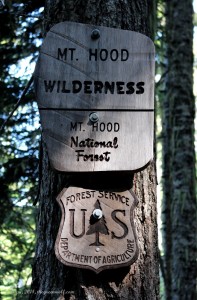
Like this:
Like Loading...


